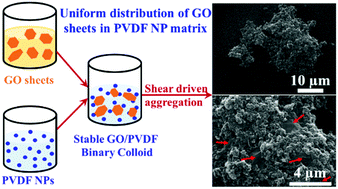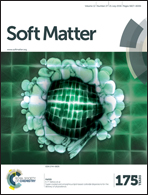Uniform distribution of graphene oxide sheets into a poly-vinylidene fluoride nanoparticle matrix through shear-driven aggregation†
Abstract
A general methodology has been developed for preparing nanocomposites with uniform, random distribution of fillers in polymer matrices, purely based on intense shear-driven aggregation, while avoiding filler aggregation. This procedure is demonstrated for a binary colloid composed of graphene oxide (GO) sheets and poly-vinylidene fluoride (PVDF) nanoparticles (NPs), both negatively charged and stable at rest. On the other hand, the PVDF NPs are shear-active (i.e. aggregation occurs under intensive shear), while the GO sheets are shear-inactive. It is found that when the two suspensions are mixed and the resulting binary colloid is forced to pass through a microchannel (MC) device (at a very high shear rate, G = 1.2 × 106 s−1), the shear-inactive GO sheets are captured and well distributed inside the PVDF NP clusters or gels. In addition, it is shown that in order to have 100% capture efficiency for the GO sheets, a minimum solid content of the binary colloid is required, which can be identified experimentally as the minimum leading to gelation after passing through the MC only one time.


 Please wait while we load your content...
Please wait while we load your content...